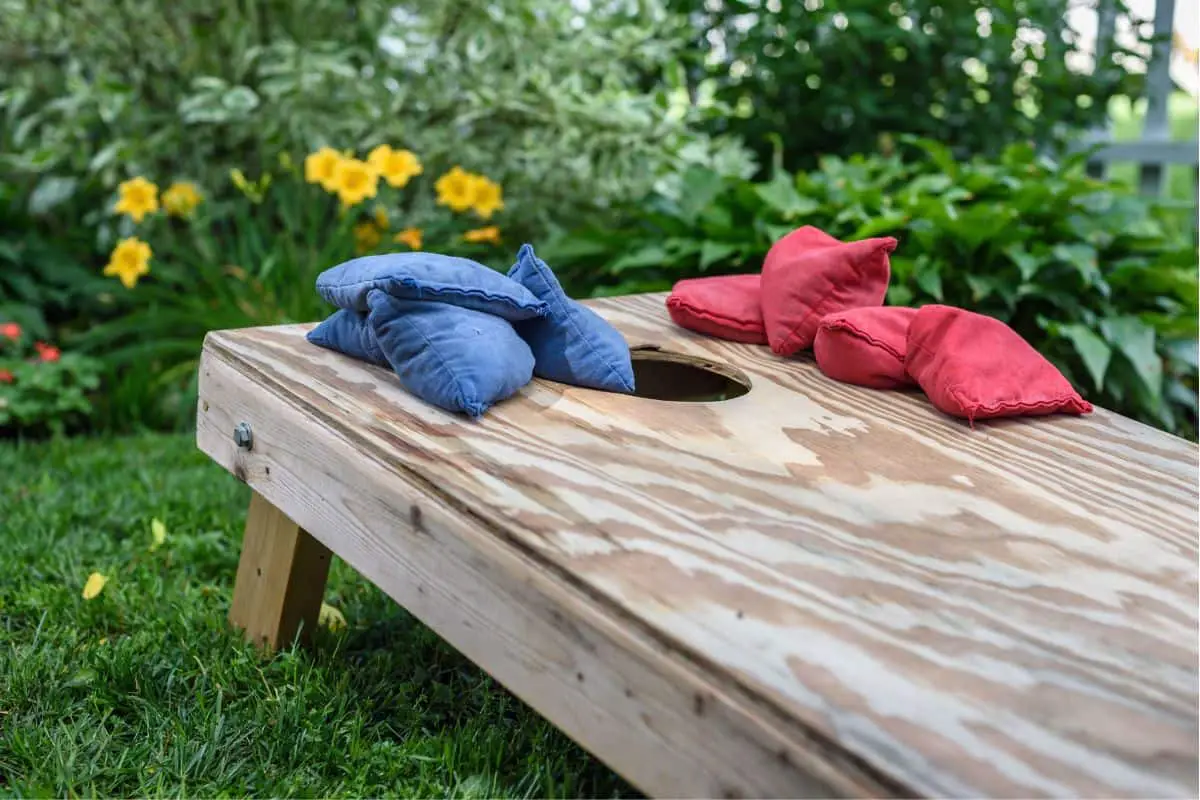The type of equipment that is needed for indoor volleyball can be broken down into two broad categories: equipment that is needed to setup the court and the equipment that a player needs for themselves.

When you’re playing in an indoor league, much of the court equipment will likely be provided. But it’s always a good idea to confirm ahead of time if something is not provided – don’t just assume that it will be! For example, many times the gymnasium permit does not include the use of volleyballs, or the ones that are there are really worn out or of poor quality. It’s kind of hard to play without a good volleyball!
Here is a list of the equipment needed for volleyball, followed by some tips and things to remember when you’re setting up and getting ready to play.
Equipment to setup an indoor volleyball court:
- Posts and cables
- Net
- Court Lines
- Antenna
- Volleyball game ball, and more volleyballs for warmup
- Ball inflation pump
- Ref stand
- Bench for teammates
And here is a list of equipment for a player:
- Shoes
- Knee pads (optional)
- Water bottle
- Sweat towel
- Ankle brace or knee brace (optional)
- Athletic clothing
These aren’t necessarily required but are good to have on hand just in case. And hopefully they won’t be needed!
- First aid kit
- Ice pack
- Sports tape
Many recreational volleyball leagues rent space from local school gymnasiums. This means that the equipment room may or may not be well organized, and you and your teammates could potentially spend a lot of time hunting down various pieces of equipment.
Equipment for setting up an indoor volleyball court
Setting Up Volleyball Posts and Cables
Most people think that the first thing you do when starting to setup a volleyball court is to grab the posts. But the first thing an experienced volleyball player actually does is uncover the holes on the court where the posts go into, otherwise known as the post holes. There is nothing more frustrating than carrying one of those (very heavy!) posts to the hole, only to have to lay it down to uncover the post hole.
And in older gymnasiums, those post hole floor covers often have a trick to them. DO NOT use your keys to open them! Believe me, you will be very tempted to do this. However, there is a very good chance your key will break! Always use the appropriate tool to open the post hole floor cover.
Sometimes there is more than one type of post, so always check that the posts you’re grabbing match the post holes in the gym floor. The cables should be attached to the poles, so you just need to make sure that you’re grabbing the correct pair of posts – depending on the style, one post will usually have the crank, and the other post will have a hook, carabiner, or other type of clip for the net.
Make sure that height of both posts is set to the correct height for your league. Posts often have a line to set the height at, which can be adjusted using a crank.

Note: for some reason, the cranks for the posts and net are the #1 piece of equipment that volleyball players spend the most time looking for in the equipment room. When you use the cranks, be kind and put them back where they belong so the next person doesn’t spend hours searching for them!
DO NOT FORGET TO ATTACH THE SAFETY PADS TO THE POSTS! This is often forgotten when setting up, and it’s so easy for a player to misjudge either their hit or their block, and land on the post. Always add the safety pads! It’s such a small thing that can make a huge difference. A volleyball court is not considered fully setup until the safety pads are attached to the posts.
Setting Up a Volleyball Net

Hopefully the volleyball net is not just piled up on the floor, in a bucket, or tangled up with a bunch of other nets. Depending on how the equipment room is organized, there may be several different styles of net. So, make sure the net you’re grabbing matches the poles that you’ve selected.
One thing to consider is investing into a team net. Splitting the fee between members keeps the costs down and helps prevent the headache of an unorganized equipment room.
We recommend the Competition Volleyball Net 32′ Olympic Spec Volleyball Nets for Tournaments
The height of the net should be set to 7 feet 11 5/8 inches (or 2.43 metres) for men’s height, or 7 feet 4 1/8 inches (or 2.24 meters) for women’s height, and is measured at the middle of the court.
If your league has a referee, they should always double-check that the height is correct. Some refs use a chain volleyball net height gauge to get the precise measurement, but many experienced refs will just extend their arm and eyeball where the height of the net lines up against their hand.
Actually, after playing a few volleyball games, many players also know when the net is off by as little as an inch or two (usually when it’s too high!), and also know where the exact height should line up when they extend their arm. If you’re not sure, think about getting a chain volleyball net height gauge so that the height is exact.
Identifying the Court Lines
For indoor volleyball, the court boundary lines will be painted right onto the gym floor. The size of the whole court is 18m long by 9m wide, so each side of the net is a 9m square.
Each side of the court also has an attack line, 3 meters from the centre line, and is identified with lines that are usually the same colour as the boundary lines. The purpose of the attack line is to separate the front court from the back court.
Always confirm which line colour is the volleyball court boundary, as gymnasium floors often have many different lines painted on them. And it’s always a good idea to do a quick scan of the court boundary lines before each serve receive, just to get yourself orientated on the court before each play.
Attaching the Antenna and Bands
The purpose of the antenna is to identify the court boundary on the net itself. If a volleyball touches either the antenna or the bands, it is considered out of play.
The antennae are attached to the net by the bands and extend about 80 cm above the net. The bands attach to the net either with Velcro, or with a hook and screw system. Or, if they’re really old, with sports tape!
Game Ball and Volleyballs for Warmup

There should be at least one good volleyball that is used for the game. Many players also bring their own ball, which is great because you want to have at least 3 or 4 balls per team for a good warmup, including serving warmup. Ideally, there should be enough volleyballs that each pair of players has one volleyball between them.
Don’t assume that the gym will allow you to use their volleyballs. Or, if they do, the quality of their volleyballs may not be the best. A decent volleyball is not very expensive, and if you plan on playing regularly, it’s a good idea to have your own volleyball.
When purchasing a volleyball, make sure you’re looking at one made with a good quality composite leather or microfiber, and not the “soft touch” backyard volleyball or plastic style. A decent volleyball can cost anywhere between $30 – $70, depending on the specific brand.
The Mikasa V200W is a good lightweight option for a game ball and for warming up. It has small dimples on the micro-fibre cover, which help with grip and control during play. Don’t forget to write your name on it, or it will get lost in the sea of purple and yellow volleyballs during warmup!
Volleyball Inflation Pump
Of course, volleyballs can get flat over time and with use. It’s a good idea to have an inflation pump in your bag. You won’t need it for every game, but do check the pressure of the ball before every game.
We recommend the Franklin Sports Ball Maintenance Kit. Gets the job done and is perfect for all types of inflatable balls.
Attaching the Referee Stand
If your league has a referee, it’s usually up to the players to attach the ref stand to the posts. The ref will always double-check that it’s attached properly (they’re the ones standing on it, after all, so it’s for their own safety!). But the ref stand is also considered part of the court setup, so the ref shouldn’t be responsible for setting up their own stand.
Don’t Forget the Bench!

Benches are often tucked away along the sides of the gym, so make sure you bring at least one bench over for teammates who are taking their turn sitting out a game. Even if your team has exactly 6 players, you’ll want the bench on the sideline so that your water bottle and sweat towel are easily accessible, and the rest of your stuff is nearby.
What equipment does a volleyball player need?
Here is a basic list of equipment that a player needs for a volleyball game:
- Shoes
- Knee pads (optional)
- Water bottle
- Sweat towel
- Ankle brace or knee brace (optional)
- Athletic clothing
For more detailed information on what to pack, check out this article:
Essential gym bag items for a recreational indoor volleyball tournament
Recommended Gear for Indoor Volleyball
What other equipment is needed for a volleyball game?
- First aid kit
- Ice pack
- Sports tape
As with any sport, there’s always a chance of injury. It’s a good idea to be prepared for this possibility. A small first aid kit is definitely worth the small amount of room it takes up in your gym bag. And also keep an instant ice pack in your bag as well, which is the kind that stay room temperature until they are activated by being squeezed and shaken up.
Sports tape is also a good idea, in case you or a teammate jams a finger – or, as mentioned above, you need to fix the antenna that keeps coming loose!
Setting up a volleyball court may seem like a daunting task, but luckily there will be at least 12 players there to pitch in. Even if you’re one of the more inexperienced players, don’t rely on your experienced teammates to always setup. If you’re not sure how something works, ask questions and help with the setup. All the players have an equal responsibility of helping with the court setup and cleanup.





Leave a Reply
You must be logged in to post a comment.